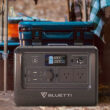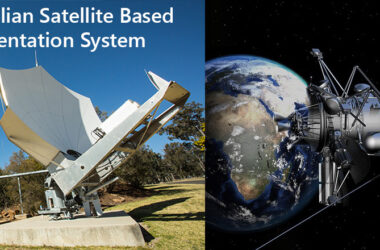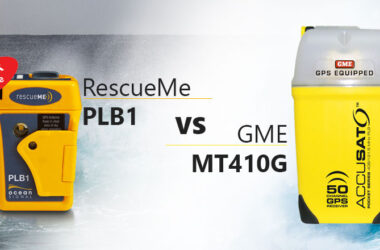The Beginning
Copyright- Kimball J Thurlow 2002 This article is not to be reproduced in any form without the written permission of Kimball J Thurlow.
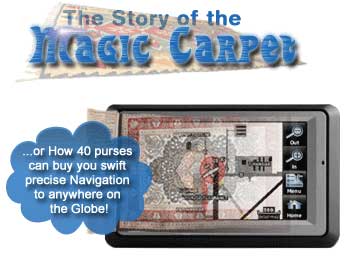
Back in 2006, I described the Garmin GPSMAP196 series as the Magic Carpet GPS. Any Garmin aviation GPS can qualify for this label if it can also show marine and street navigation. With that ability, they put me in mind of a machine that can magically transport a traveller from one point to another, regardless of his mode of travel. This GPS combines all the functionality of panel-mounted aviation GPS and the autoroute calculating functions of in-car navigation. As well, they can read marine charts to assist navigation of vessels through charted waters. And they can also be used as hand-held GPS. Then it begs the question of where companies like Garmin can take us with this technology, in the next generation?
GPS in modern times helps ordinary people to arrive at any destination without any seeming effort. Effortless travel intrigued the ancients, and the story of one such achievement has come to us through the annals known as the "Arabian Nights".
Firstly, let us acknowledge the contribution made by the Arab peoples in long ago times (along with Egyptians BC, and Chinese and Western cultures AD), in the arts of mathematics, astronomy and terrestrial measurement, all of which are the basis for our space and geomatic sciences.
Carpets, whether knotted or flat woven (kilim) are very practical homemakers, particularly where temperature fluctuations between day and night, summer and winter may vary greatly. In regions such as Turkey, Arabia, and Central Asia, woven carpets were extensively used, and became both practical and art objects, by covering the floors, and sometimes walls and doorways. The carpets are always hand made of wool or sometimes cotton, with occasional additions of silk. The flat woven kilims which are frequently embroidered are used as blankets, curtains, and covers over sofas or as cushion covers.
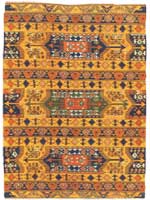
With acknowledgement to:
Ülkü Bates, Ph.D., Professor of Art History, Hunter College, New York City
Carpet Weaving
My article is going to mix a little home science with a little myth, and hopefully raise a good story, which may prove true; at the least entertaining.
Transport from one place to another geographically has always been fraught with danger. Partly because of natural obstacles (rivers, hills) and also because of unfriendly peoples (and animals) by whom you have to pass (including brigands and robbers). But there is the other problem, of which way and how far, and how not to get lost. And from ancient times this has been done by knowing the lie of the land in your own locality, but also by other means for further afield.
Firstly, it becomes known by experience, and from what your father told you, that to reach Zee, you walk one-half a day toward the rising sun, then another half a day with the sun in front of you, then later over your left shoulder. By nightfall, you should reach Zee. {This is the time method; you could also use the number of paces (= distance), but counting becomes tedious}
Desirably, this instruction can be written down for absorption by others. One of the easiest ways to do this is graphically, and what better method than a piece of cloth, which you weave in your own home from local fibres. The woof thread runs one way in the weaving shuttle, and the warf thread runs the other. So you have a piece of cloth with a natural check pattern, which can easily represent both direction and distance. The woof can represent the direction to the rising sun, and the warf can represent the direction to the noon sun (at right angles to the woof of course). Each thread of the weave can represent a distance. Perfect.
Arabian Science
When faced with distance and direction problems in the treatise above, it becomes useful to understand the size of the globe on which we live. For example, the length of a shadow in Brisbane on a certain day and time will differ in length from a shadow in Sydney, and from Melbourne. Differences in shadow lengths will be proportional to the distances between cities. By building up a table of shadow lengths and distances, we could become rather expert at knowing how far to go to a destination. Similarly, we can actually determine how far you are from the equator, and so on. Way back in AD820, Caliph Al-Mamun in Arabia, observed these principles, and actually managed to calculate the size of our globe. (As did Ptolemy in 110BC, Reference: publIntroduction to Geodesy, The History and Concepts of Modern Geodesy, by James R SmipubJohn Wiley and Sons, Inc)
Arabian Nights
At the same time as this scientific publicity, Arabian scribes were putting pen to paper to preserve stories from the region. These are still very well known and popular and include the tales of Sindbad and Scheherazade. (With acknowledgement to John Crocker, an expert in matters relating to the ancient Arab writings and cultures. )
The first identifiable written version of the Arabian Nights seems to have been a book of Persian tales called Hazar Afsanah (A Thousand Legends), translated into Arabic around A.D. 850. The Arab writer Al-Mas'oodi (who died in A.D. 956) refers to this book and reveals that it is known as Alf Layla (A Thousand Nights).
The following scene from the story of ‘Prince Ahmed and the Fairy Pari Banou’ is set in Bisnagar, the ancient Hindu capital city of southern India; the story has three sons compete for the hand of a princess. The successful suitor will prove his worth, by presenting the princess's guardian with a marvel, more fantastic than the others. Our interest lies with Prince Houssain, the eldest of the three.
"After Prince Houssain had run through that division, street by street, his thoughts fully employed on the riches he had seen, he was very much tired; which a merchant perceiving, civilly invited him to sit down in his shop, and he accepted of it; but had not been sat down long, before he saw a crier pass by with a piece of tapestry on his arm, about six foot square, and cried it at thirty purses. The prince called to the crier and asked him to see the tapestry, which seemed to him to be valued at an exorbitant price, not only for the size of it but for the meanness of the stuff. When he had examined it well, he told the crier, that he could not comprehend how so small a piece of tapestry, and of so indifferent appearance, could be set at so high a price. The crier, who took him for a merchant, replied, If this price seems so extravagant to you, your amazement will be greater when I tell you I have orders to raise it to forty purses, and not to part with it under. Certainly, answered Prince Houssain, it must have something very extraordinary in it, which I know nothing of. You have guessed it, sir, replied the crier, and will own it, when you come to know, that whoever sits on this piece of tapestry may be transported in an instant where-ever he desires to be, without being stopped by any obstacle."
And so Prince Houssain was short of forty purses, but possibly betrothed to a beautiful princess.
Carpets tell a Story
.... he could not comprehend how so small a piece of tapestry, and of so indifferent appearance, could be set at so high a price...... We assume that myths have some origin in fact. Is it possible that Prince Houssain was handed a carpet that was simply a map, which enabled him to traverse the land speedily and effectively? A map made from the tapestry, where each woof and warf is a representation of a real place, or road or some physical geographic attribute, may not appear particularly attractive, especially to the trained symmetrical eye. But if it can direct you certainly to any place in the habitable world, then it is a marvel that has no price. Imagine this piece. Small coloured threads represent towns and streets, different colours woven in lines represent roads or byways, and so on
The concept of the woven carpet is exactly the same as our modern mapping grid systems. Each thread in the carpet represents a distance in either the north (south) or east (west) direction. Due to continual refinement in our measurement of the globe (particularly over the last 200 years), we now rely not only on maps but on satellite pathed navigation systems, that actually use the same grid system. Our modern geographic location systems use grids that can be theoretically represented to millimetres and regularly do so in practice to 1cm, by surveying quality GPS.
But of course one has to learn the method and use of the map. We learn in school, about compass points, North south east and west, about distance and measurement. And applying that knowledge to reading a map, has long been the subject of dispute between husband and wife. Is it easier to point the map in the direction of travel, or line it up with the north point? The answer depends on your spatial understanding. So I doubt if there is a right or wrong way. The human brain is certainly smart when absorbing the streets, and possible routes on an urban map. But as soon as you start to travel, what seemed like a logical sequence of turns, becomes mixed up in street signage, traffic hazards, and intersections that suddenly seem larger or more important than they did on the map, and so on. But enter mathematics and computers, and we find they can certainly make it easier for us.
Shortest Path Algorithms
Computing has enabled continuous calculations that in practice, could never have been done by hand. One such calculation is the shortest path algorithm, a mathematical method used to calculate the "least cost" from one point to another. "Least cost" may refer to shortest distance, lowest fare, least energy, or any other parameter. So the algorithm could be applied to design of electronic circuitry, water reticulation, or any application requiring travel of any particle or substance in the MOST effective manner.
The algorithm reduces the problem to a graphical one. In applying it to travel geographically, the required solution may be the shortest or the quickest. Either method uses the same basic graphical sequencing, with slightly different attributes on the possible path.
The mathematical terms for a position, or destination, is a vertex (a layman's term may be a node). Edges are the lines or routes connecting those nodes (another term for this could be a vector).
In order to find the shortest path from a position, to a destination (a vertex), it is necessary to find the shortest path from that position to every other adjacent vertex, that may create a path to that destination. In turn, the shortest path vertex then becomes the basis of a search for the shortest path to every adjacent vertex, that may create a path to the destination, and so on. Dijkstra's algorithm (named after Edsger Dijkstra) sequentially queries each adjacent node for least cost (or distance or time), until it arrives at a single complete solution for the best path through adjacent nodes to a destination. (Reference: Data Structures and Algorithms, Bruno R Preiss, John Wiley and Sons Inc, 1999.)
Smart Mapping
And so to a conclusion, for now. The knowledge that computers can find a quicker route is not much comfort without a practical advantage for us. Companies like TeleAtlas (tools for computer mapping) have contributed, and Sensis (through their Whereis Navigation subsidiary), have already completed substantial detail for Australian highways, roads and streets, and applied the shortest path algorithms to benefit end-users.
The computing ability of even a small hand-held GPS is a marvel. Combine that with the ability to calculate street by street to a destination, and show you on a moving map screen is perfect. And this is what our Magic Carpet GPS can do. As well as give us the runway length and direction of the nearest airport. Which is great if you're an aviator. All of the GPS we supply, are Magic Carpet things in a way. And when you see any available automotive or personal navigator, which also speaks to you (street by street, turn by turn), then you know you really have secured some very powerful mapping technology, in concert with global positioning technology. If that adds up to less frustration, less fuel burnt, and time saved, it will be money well spent.
We do not promise you the hand of a princess, or even a prince, but we can help when it comes to spending 40 purses on some really useful stuff like GPS.
Edsger Dijkstra (1930-2002) made many more contributions to computer science than the algorithm that is named after him. Dijkstra was a prodigious writer. His entire collection of over thirteen hundred written works has been digitally scanned. He also corresponded regularly with hundreds of friends and colleagues over the years --not by email but by conventional post. He strenuously preferred the fountain pen to the computer in producing his scholarly output and letters. Edsger Dijkstra passed away in August 2002, and you will find an obituary published by the University of Texas


